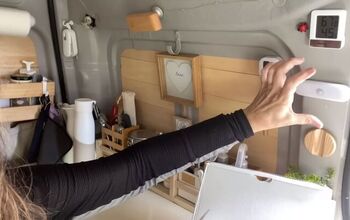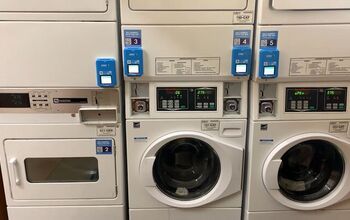Van Life: Is My Van TOO Small?

When I pull up to a campground or a van life event, I often notice the curious glances directed my way.
Surrounded by massive RVs, big Sprinter vans, or Ford Transits, my tiny van stands out like a sore thumb. Comments like "How adorable, but how do you function in such a tiny space?" or "Cute, but way too small—why don't you get a bigger van?" are not uncommon.
Today, I want to share exactly why I chose my tiny van and why I haven't regretted it for a single minute.
1. The decision: why a tiny van?
It’s rainy outside today, so it seems like the perfect time to talk about why I decided to live in such a tiny van.
When I first started exploring van life, I spent over a year researching different types of vehicles, watching countless videos, and trying to envision what van life would be like for me.
I was initially drawn to those picturesque scenes where the back doors of a van are flung open to reveal a beautiful bed with an equally stunning view beyond it.
But as the illusion wore off, I began asking more practical questions.
2. Cost: a key factor
The first and perhaps most significant factor that influenced my decision was cost. I started questioning how much a large van like those in the videos would cost. How much would a typical build-out cost? What about insurance, gas prices, and mileage?
At that time, I knew I enjoyed the van life lifestyle because I had already converted an SUV into a temporary camper and had gone on several trips. However, I couldn’t justify spending a mortgage-sized sum on a vehicle that I wasn’t sure I’d use for more than a few years.
So, I shifted my focus to more budget-friendly options, which led me to mini cargo vans like the Ram ProMaster City, Ford Transit Connect, Mercedes Metris, and Nissan NV200.
The main attraction was the price point. These smaller vans were significantly less expensive, and I found a 2010 Ford Transit Connect with only 69,000 miles on it for just $6,995.
Although I initially hesitated because it was red and I had envisioned a more "stealthy" white van, this van checked all my boxes. The build-out was a no-frills project that cost me just under $1,600 and took about a month to complete.
For me, the cost made this tiny van the perfect choice.
3. Fuel economy: saving at the pump
Another crucial factor in my decision was fuel economy. The Ford Transit Connect averages 25 to 27 miles per gallon on the highway, and I often get upwards of 30.
This is a significant advantage, especially when you consider the gas mileage of larger cargo vans. For instance, a GMC Savana 1500 gets about 14 miles per gallon in the city and 17 on the highway. A larger Ford Transit averages around 14.48 miles per gallon.
Gas mileage is heavily influenced by factors like driving conditions and the weight of the build-out. By keeping things light and minimal in my van, I’ve managed to maximize my fuel efficiency, which is essential given the current gas prices. Fuel economy was definitely a major reason I opted for a tiny van.
4. Maneuverability: navigating with ease
Maneuverability was another significant consideration. While I have experience driving larger vehicles, the idea of navigating city streets, public parking, and washboard dirt roads in a large van made me think twice.
My tiny van, on the other hand, fits through car washes, drive-throughs, public parking spaces, and even parking garages.
Recently, I had to attend meetings in Washington, D.C., and my van fit perfectly in a public parking garage. Its front-wheel-drive system handles well in various conditions, including dirt, sand, and snow.
Coming from a snowy region, the front-wheel-drive was a key reason I chose the Ford Transit Connect over other small cargo vans or larger models.
5. Repair and maintenance: keeping costs low
Repair and maintenance costs were also a deciding factor. On average, the annual cost for repairs and maintenance on a Ford Transit Connect is about $740, compared to $1,600 for a Mercedes-Benz Metris and $795 for a Ram ProMaster City. Only the Nissan NV200 costs less, with an average of around $645 per year.
Additionally, Ford has a vast network of dealerships and a decent availability of parts, making it easier to find service and repairs wherever I am in the country.
This availability played a significant role in my decision, as I’ve heard from others about the challenges of repairing and maintaining other brands, especially Mercedes and Ram.
While this is anecdotal, my experience has been that Ford is easy to service and repair, and that has been a huge advantage for me.
My love for tiny van life
Of course, tiny vans have their drawbacks, like not being able to stand up inside and having limited storage. But for me, the lack of storage has forced me to prioritize what’s truly necessary for comfortable living.
I’ve found that I value experiences more than things, so I count this as a positive rather than a drawback. Not being able to stand inside just encourages me to get outside more and enjoy all the adventures van life has to offer.
I hope my experience helps you as you consider what type of van is right for you. For me, choosing a tiny van made perfect sense, and I haven’t regretted it for a minute. Share your thoughts in the comments down below.
Next, check out my 6 Top Sleeping Hacks for a Good Night's Rest.





















![101 Items to Get Rid of With No Regret [Free Declutter List]](https://cdn-fastly.thesimplifydaily.com/media/2022/08/30/8349390/101-items-to-get-rid-of-with-no-regret-free-declutter-list.jpg?size=350x220)
Comments
Join the conversation